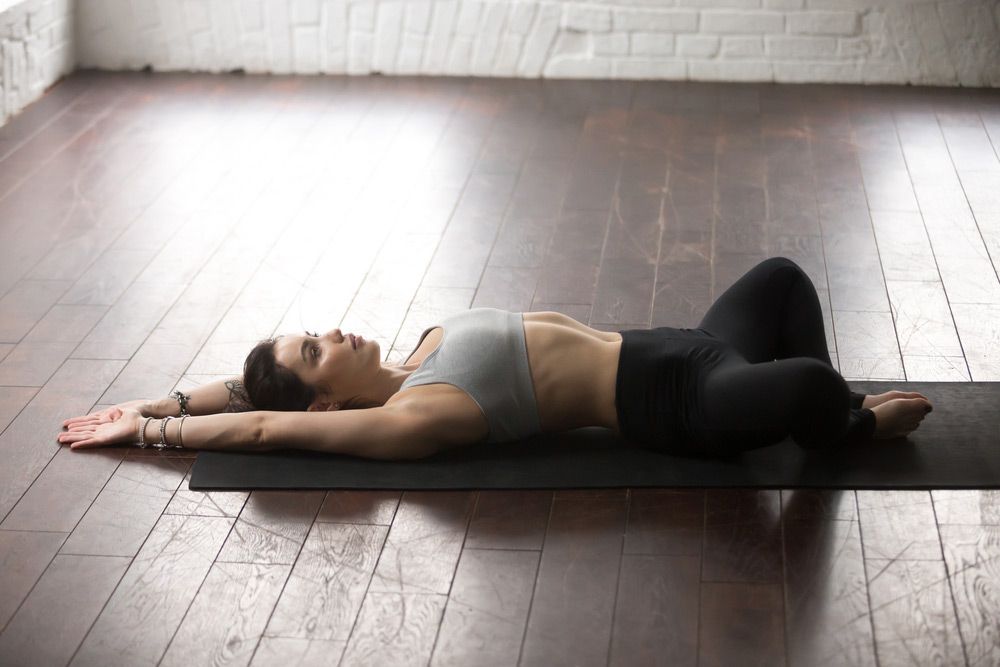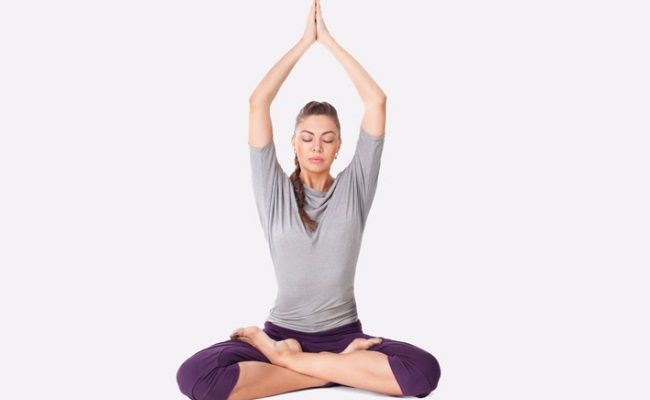What is Swastikasana (Auspicious Pose)?

Swastikasana, or Auspicious Pose, is a meditation pose for practitioners who are unable to attempt the more challenging asanas like Siddhasana and Padmasana.
In this yoga asana, one leg is placed on top of another, and then the position is stabilized. In Swastikasana, this part of the legs resembles the symbol of the Swastika.
In yoga, Swastikasana asana is widely used as a seated meditation and Pranayama pose. As a result, this can be described as an exercise that helps calm the mind and attain realization of the unity of existence.
Overview & Etymology
The word comes from the Sanskrit root words ‘Su,’ meaning success or prosperity, 'Asti' means existing and 'Ka' means making something happen.
The Swastika has been in Indian culture for more than 5000 years. This is a symbol of peace and auspiciousness, and Hindus use it at the start of every spiritual or cultural festive event.
This pose has been described in the 11th-century Hatha Yoga text, Vimanarcanakalpa, and was attributed to the sage Mareechi.
Sanskrit Name: स्वस्तिकासन Pronunciation: Swa-uh-st-ihk-aa-sun-aa
Pose Type: Seated Also known as: Auspicious Pose
Strengthens: Mind, Spine, and Neck
Stretches: Knees, Ankles, and Groin
Health Benefits of Swastikasana
Improves posture.
Opens the pelvic muscles.
Relaxes and rejuvenates the mind.
Strengthens the knees and ankles.
Enhances the flow of Prana (energy) in the body.
Increases mental focus and mindfulness.
Aligns the spine and strengthens the back.
Activates the Muladhara Chakra and Ajna Chakra.
When to Avoid Performing Swastikasana
Avoid if you have severe back pain.
Avoid if you have sciatic issues.
Avoid if you have a slipped disc.
Avoid if you have had a recent surgery.
Avoid if you have inflammatory knee arthritis.
Avoid if you have a severe injury in the knees or spine.
How to do Swastikasana (Auspicious Pose)
Below the practice is divided into four parts: preparation, posture step, alignment cues, and relax flow.
Later you will come across a few posture modifications and variations for beginners and intermediates to modify their practice if needed.
Part 1: Preparation for Swastikasana
To prepare for the Auspicious Pose, you must warm up your legs, core, and glutes. Here are a few poses that can help:
1. Dandasana (Staff Pose) - Sit in the center of your mat and begin with your legs extending in front of you, with your toes pointing toward the ceiling. Keep your spine upright, your hands placed to the side of your hip flexors, and your gaze focused in front of you.

Hold this pose for 60 to 90 seconds while engaging your core muscles. This posture will activate your hamstrings, glutes, ankles, and core muscles.
2. Baddha Konasana (Cobbler's Pose) - This is the best yoga posture to reach the deepest parts of your glute muscles. Start by taking a seat in the middle of the yoga mat with your back straight. Now, bend your legs from the knee and make a prayer formation with your legs.

Hold your feet together with your hands, keeping your knees close to the mat, and maintain this pose for 60 to 90 seconds. For a deep hip and thigh opening, you can lean forward or try to do butterfly flaps with your legs.
3. Sukhasana (Easy Seated Pose) - Sit in the center of your yoga mat with your sitting bones at ease. If your sitting bones hurt, add some folded blankets under your glutes to make them more comfortable.

Now, interlace your legs so that your right foot is placed below your left knee and vice-versa. Hold this pose here for 3 to 5 minutes with a straight spine. This pose is closely related to the positioning of the Auspicious Pose.
Part 2: Step-by-Step Instructions to Perform Swastikasana
The following are steps to practice Swastikasana or Auspicious Pose:
Step 1: Take a seated, upright position on the floor and spread both legs in front of you.
Step 2: Start by simply bending your left leg from the knees and placing your left foot's sole on the inside of your right thigh.
Step 3: Next, bend your right leg from the knee and place your right shin in the space between your left and thigh muscles.
Step 4: Make sure your knees are touching the yoga mat. Engage your core and straighten your spine. Keep your hands in Gayan Mudra against your knees and close your eyes.
Step 5: Relax your whole body by breathing consciously. You can also practice Pranayama or Meditation in this position for a mindful session.
Breath Awareness:
Keep your breathing regular and at a steady pace. Make sure to breathe deeply and exhale twice as much as you breathe in.
Performance Duration for Beginners: Hold Auspicious Pose for 5-10 minutes.
Performance Duration for Advanced: Hold Auspicious Pose for as long as it feels comfortable.
Part 3: Things to Keep in Mind
Being conscious of your sitting posture is important, especially when you are performing this asana for a long duration. Below are some Auspicious Pose alignment cues to keep you safe from injury:
Avoid rounding of the spine: Only a straight and upright back during Swastikasana will help you reap the most health benefits of the pose. If your back hurts and you’re unable to keep it upright, try sitting beside a wall and to build some strength in your spine.
- Don’t cross the same leg for too long: Make sure that you interchange your crossed legs after a few minutes. This will ensure a balanced engagement of both of your legs and prevent restriction of blood circulation in any one leg. You can change your legs after every 2 minutes.
Part 4: Relaxing Poses After Swastikasana
After a long sitting session in Swastikasana, it’s helpful to regain blood circulation back around your legs and hip muscles. Here are a few counter yoga poses for relaxation after your long Auspicious Pose practice:
1. Baddha Konasana Uttanasana (Bound Angle Forward Bend): After the Swastikasana practice, change your leg placement into Namaste formation. Hold your feet with your hands and gently bend your upper body forward on the ground.

Bend forward only as much as you feel it’s comfortable for your back and glutes to tolerate. This pose will help your spine to relax, and your glutes activate blood circulation after a long Swastikasana practice.
2. Supta Baddha Konasana (Reclining Bound Angle Pose): This posture will bring the spine into a natural shape, stimulate your heart, and relax the pelvis. From the Bound Angle Forward Bend, sit back up in Baddha Konasana for a few deep breaths. Maintain the prayer formation in your legs, exhale deeply and gently bend your torso back toward the ground.

First, place your hand on the ground, then your tailbone, then your mid-back, and finally your neck. Take a few deep breaths, close your eyes, and unwind your entire body. Push your knees outwards and try to keep them close to the ground.
Swastikasana Variations to Consider
Below you can find some interesting Auspicious Pose variations that you can incorporate into your regular yoga practice:
1. Auspicious Pose with Raised Arms: Begin by aligning your lower body in Auspicious Pose. Now, engage your core, inhale and lengthen your torso as you bring your arms overhead. Exhale and slowly move your shoulders away from your ears.

Hold this pose with raised arms for 1 to 5 minutes and feel the burn in your shoulders. This posture variation will help you increase your shoulder and spinal strength.
2. Auspicious Pose Forward Bend: Get into Auspicious Pose with your legs and take a few deep breaths. Inhale deeply and exhale even deeper as you start to gently bend forward from your torso.

Round your spine and engage your core muscles. Rest your forehead on the mat and extend both of your arms in front of you. Hold this pose for 1 to 5 minutes and this pose will stretch the entirety of your back muscles as well as your deep pelvic muscles, making them stronger and flexible with time.

Enjoy a Free 1-on-1 Session with a Coach!
Receive personalized guidance tailored to your unique fitness goals, live with a dedicated coach—no credit card required.
Frequently Asked Questions about Swastikasana
The following are a few health benefits of Swastikasana:
- Improves sitting posture.
- Improves spine alignment.
- Strengthens the back and legs.
- Eases lower back and neck pain.
- Soothes the nervous system and calms the brain.
- It enhances the circulation of blood in the pelvic region.
- Activates the root chakra and third eye, which enhances the flow of Prana (energy).
Yes, beginners can perform Swastikasana pose easily. If you have issues crossing your legs in Padmasana or Siddhasana, then getting started with the Swastikasana pose would be a wise choice for you. Beginners can also hold the Swastikasana pose for longer durations without any pain or discomfort because of its easy cross-legged placement.
If you have any of the following ailments then you should not perform Swastikasana:
- Knee arthritis.
- Sciatic nerve pain
- Chronic back or neck pain
- A recent knee, back, or spinal surgery
- Pregnant women with swollen feet or lower back pain.
There are a few posture variations for Swastikasana, like raised arms overhead in the Auspicious Pose, or forward bending in the Auspicious Pose. You can perform these variations as per your preference and physical capabilities.



.webp)
%20(7).jpg)




